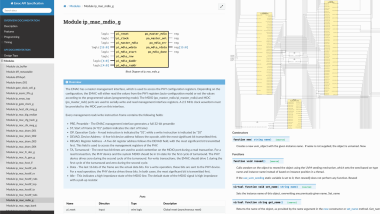
Specador is a tool that automatically generates accurate documentation from the source code.
Automatically generates accurate and effective documentation from the source code.
Enables the documentation process automation.
Saves time and reduces maintenance costs.
Enhances IP packaging.
Specador enables design and verification engineers to easily create and maintain proper and well-organized documentation. It generates HTML or PDF, works in batch mode (command line) and uses dedicated language parsers.
This documentation generator compiles the code and understands the project structure, so users can utilize it to document design or verification environments, even when comments are not present to provide additional context. Thus it can create for example, cross-linked class inheritance trees, design hierarchies, and diagrams.
Specador can be easily integrated into existing development flows. The documentation is always in sync with the source code, eliminating meticulous and problematic tasks like maintaining diagrams or updating lists of ports or function arguments to reflect the current version.
Specador is especially useful for packaging IPs, either for the IP providers or for those using an IP-oriented flow in their company.
Specador recognizes the Markdown and reStructuredText syntax, which can be used to format the documentation comments as desired to enhance the readability of the HTML or PDF output.
Features
- Language awareness. The documentation is organized by language-specific concepts, including both relationship and structural information. For example, there are dedicated categories for packages, classes, entities, modules, or structs and one can easily explore the class inheritance, the design hierarchy or entity architectures.
- Cross-linked documentation. Allows users to easily jump from the function documentation to one of its arguments or from the module definition to one of its submodules
- Hyperlinked diagrams. Automatically generates diagrams such as Block and Schematic Diagrams or Inheritance and Collaboration UML Class Diagrams. The diagrams are hyperlinked, enabling users to click on a class in a diagram and jump to the chapter where it is documented or on a submodule in a schematic to jump to the submodule chapter.
- Bitfield diagrams. Produces bitfield diagrams by parsing packed data types or the UVM register configurations methods.
- Waveform diagrams. Creates waveforms specified using the popular open-source WaveDrom format.
- Customized diagrams. The documentation generator can take directives in comments, feed them to an external script/tool for processing, and include the generated results in the documentation
- Review-oriented sections. The documentation contains sections that aggregate information focused on the coverage or checking aspects, for example.
- Quick search. Users can easily search through the generated documentation
- Enhanced readability of the HTML and PDF output. Because Specador recognizes the Markdown and reStructuredText syntax, users can beautify the HTML and PDF output by using attributes like bold, italic, and lists.
- Documentation control. Users can control what documentation they create. They can filter out whole packages or private APIs, or select what API subset will be documented if they don't want to expose an internal API.
- Additional embedded or linked documentation. One can easily embed external documentation, add additional menus in the table of contents, add links to MS Word, PDF documents, or extra screenshots, and integrate with other documentation frameworks
- Scalability. Specador automatically creates cross-links to pre-generated documentation of other IPs or projects.
Why choose Specador Documentation Generator
- Generates well-organized and effective documentation, even from limited source code comments.
- Integrates easily into existing development flows allowing design and verification groups to automate the documentation process.
- Keeps the generated documentation in sync with the source code, therefore saving time and reducing maintenance costs.
- Enhances IP packaging.
- Encourages proper source code documentation.

